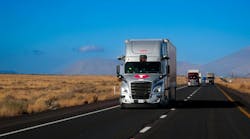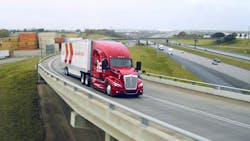With the development and deployment of autonomous vehicles in the trucking industry ramping up, drivers, fleet operators, and legislators have considered how these vehicles will impact the commercial trucking landscape, with some regulating AV technology and others avoiding the topic overall.
But as of the end of 2023, several AV developers are beginning to move toward scaled development, gradually introducing these vehicles to America's roadways. While this doesn't mean the roads will be flooded with self-driving trucks tomorrow, fleets should be aware of next steps for this technology and how it will impact their businesses.
“While there may be new training requirements, technicians familiar with today’s electronic diagnostic systems should find the shift to servicing autonomous-enabled trucks fairly straightforward,” Elder said.
Beyond servicing AVs, Gatik’s Steiner emphasized how maintenance teams must go deeper on their post-service and pre-trip inspections.
“We have teams working on the pre-trip inspection aspect of things, [too],” Steiner noted. “We’re doing this before every single trip with every single aspect of our technology.”
See also: Kodiak’s self-driving trucks join Martin Brower’s fast-food supply chain
This includes verifying that every technological integration—from lidar, radars, and cameras to global positioning systems—are all in working order.
Looking ahead for AVs
What do the next few years of AVs look like now? For many of the remaining tech developers, the goal is to expand the routes that their vehicles can handle, all while continuing to build their safety cases and adapt to the unusual road events a human driver might understand, but a computer will not.
For Gatik, this means scaling up from 65 trucks commercially deployed in North America to 300 by the end of 2025. This starts with growing the company's Class 6 autonomous box truck operations in Dallas.
For Kodiak, the first order of business is to continue collecting data.
“We need to finish building what we call [AVs’] safety case, which is basically the proof that this system is safer than a human,” Kodiak’s Goff explained. “It’s really a steady accumulation of data that shows we can handle [a] very wide range of scenarios, we understand what is and is not likely to happen on the road, and we’re prepared for it.”
This means covering more miles with driverless trucks and comparing how the Kodiak Driver program behaves compared to a typical driver with the same number of miles under their belt. This also entails recording as many unusual or surprising road events as possible, tagging and evaluating them, and making sure that the software knows how to respond to such scenarios, all without accidentally "unlearning" something the team previously programmed into the software.
All of these processes take time. And they’re partially why Stefan Heck, founder and CEO of Nauto, an AI and data platform for driver coaching, safety, and AV development, is certain that scaling AVs at the fleet level will still be a gradual process and roll out slowly across highways and regions.
“The bus systems will expand a little bit; the trucks will add Interstate 15 [to their AV capabilities],” Heck hypothesized. “And then eventually, somebody will figure out how to do Interstate 80, which is much more complicated because you’re going through Chicago and you’re going through snow.”
How AVs address the formidable challenges of blizzards and gridlock is uncertain at this moment, but it does appear developers are coming closer to figuring out the basics of autonomous trucking operations. It’s a long road ahead, but it’s a start.




